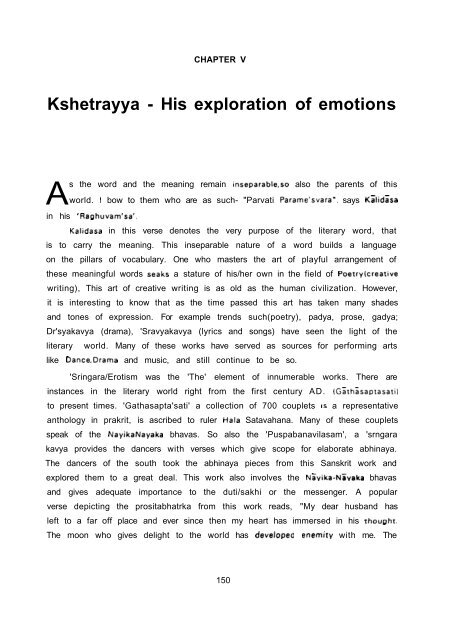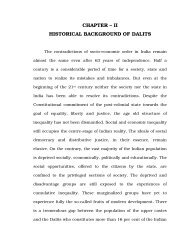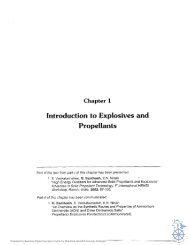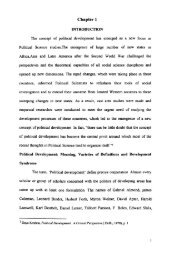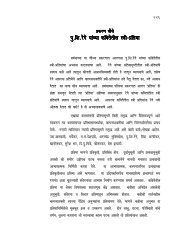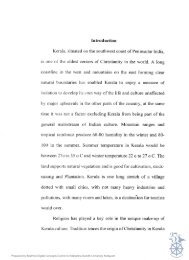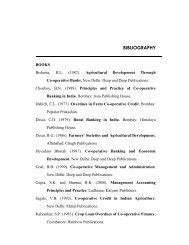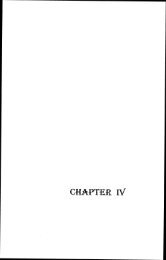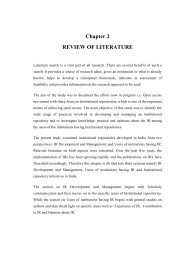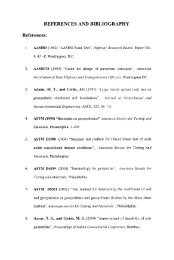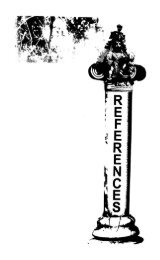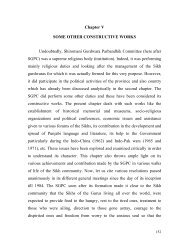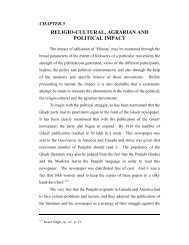Kshetrayya - His exploration of emotions
Kshetrayya - His exploration of emotions
Kshetrayya - His exploration of emotions
You also want an ePaper? Increase the reach of your titles
YUMPU automatically turns print PDFs into web optimized ePapers that Google loves.
CHAPTER V<br />
<strong>Kshetrayya</strong> - <strong>His</strong> <strong>exploration</strong> <strong>of</strong> <strong>emotions</strong><br />
As the word and the meaning remain inseparable,so also the parents <strong>of</strong> this<br />
world. I bow to them who are as such- "Parvati Parame'svara", says Kalidlsa<br />
in his 'Raghuvam'sa'.<br />
Kalidasa in this verse denotes the very purpose <strong>of</strong> the literary word, that<br />
is to carry the meaning. This inseparable nature <strong>of</strong> a word builds a language<br />
on the pillars <strong>of</strong> vocabulary. One who masters the art <strong>of</strong> playful arrangement <strong>of</strong><br />
these meaningful words seaks a stature <strong>of</strong> his/her own in the field <strong>of</strong> Poetrytcreative<br />
writing), This art <strong>of</strong> creative writing is as old as the human civilization. However,<br />
it is interesting to know that as the time passed this art has taken many shades<br />
and tones <strong>of</strong> expression. For example trends such(poetry), padya, prose, gadya;<br />
Dr'syakavya (drama), 'Sravyakavya (lyrics and songs) have seen the light <strong>of</strong> the<br />
literary world. Many <strong>of</strong> these works have served as sources for performing arts<br />
like Dance.Drama and music, and still continue to be so.<br />
'Sringara/Erotism was the 'The' element <strong>of</strong> innumerable works. There are<br />
instances in the literary world right from the first century AD. (Gathlsaptasati)<br />
to present times. 'Gathasapta'sati' a collection <strong>of</strong> 700 couplets is a representative<br />
anthology in prakrit, is ascribed to ruler Hala Satavahana. Many <strong>of</strong> these couplets<br />
speak <strong>of</strong> the NayikaNayaka bhavas. So also the 'Puspabanavilasam', a 'srngara<br />
kavya provides the dancers with verses which give scope for elaborate abhinaya.<br />
The dancers <strong>of</strong> the south took the abhinaya pieces from this Sanskrit work and<br />
explored them to a great deal. This work also involves the Nlyika-Nayaka bhavas<br />
and gives adequate importance to the duti/sakhi or the messenger. A popular<br />
verse depicting the prositabhatrka from this work reads, "My dear husband has<br />
left to a far <strong>of</strong>f place and ever since then my heart has immersed in his thouoht.<br />
The moon who gives delight to the world has developed enemity with me. The<br />
150
sounds <strong>of</strong> the cuckoos precipitate my pangs. The cool breeze <strong>of</strong> the gardens<br />
are carrying away my life, oh dear friend! How do I bear this torture'. Such<br />
verses give a clear picture <strong>of</strong> the nayika-avasthas in a visually presentable way.<br />
A verse from Kalidasa's Malavikagnimitram also depicts the state <strong>of</strong> the nlyika<br />
in a similar way,"Oh! dear heart, kindly loose hope on him who is impossible<br />
to you. How is it that my right limbs are indicating this bad omen to me. How<br />
would I approach him who is visible after a longtime. Oh dear ! Do not consider<br />
me as someone else's. Kindly recognise as the one interested in you". While<br />
this verse from a Drama makes the heroine speak for herself, the above verse<br />
which is a stray description <strong>of</strong> the heroine (in no connection) makes her speak<br />
to her friend. The friend speaking on the behalf <strong>of</strong> the heroine or the hero are<br />
the most common imaginations <strong>of</strong> the poets <strong>of</strong> erotic poetry. An example <strong>of</strong><br />
such kind can also be had from 'Puspabana vilasam',"The melodious sounds <strong>of</strong><br />
the cuckoos, pleasantness <strong>of</strong> the moon, cool breeze, all these have now turned<br />
against her due to your delay in difference and are precipitating her pangs and<br />
making her suffer to death. She is at the threshold looking for you and is<br />
expecting you at every sound and move around her. She is some how managing<br />
to survive to see you. If you do not turn up even now.she is certain <strong>of</strong> giving<br />
up her, whose life is your's" 3 .<br />
Whether in a context (in a drama) or as a piece <strong>of</strong> stray verse the<br />
Nayika-Nayaka bhavas have gained immense interests <strong>of</strong> both the poets and the<br />
performers. This concept has even given rise to a trend in poetry writting in<br />
Sanskrit, which later influenced many regional writers to produce works on same<br />
lines in their respective languages.<br />
It is Jayadeva <strong>of</strong> twelth century A.D. who first came out with the richest<br />
and finest <strong>of</strong> the 'Srngara-rasa-kavyas. The Astapadis <strong>of</strong> hit 'GitaGovinda kavya'<br />
stand as the best <strong>of</strong> the abhinaya pieces. The <strong>emotions</strong> depicted by him in the<br />
characters <strong>of</strong> Radha and Krishna are very down to earth and make one feel<br />
identified with them. However, the interpretation <strong>of</strong> Madhurabhakti, the relation<br />
<strong>of</strong> Jfvatma and Paramatma through the characters <strong>of</strong> Radha and krishna give a<br />
touch <strong>of</strong> philosophical approach to them.<br />
Coming to the Telugu literature the credit <strong>of</strong> writting Padas goes to the<br />
great Tallapaka poet Annamacharya, who laid foundation for a very fluid expression<br />
<strong>of</strong> otherwise abstract thoughts <strong>of</strong> human minds. This fifteenth century poet is<br />
151
credited with as many as thirty thousand 'srngara and Sdhyatma kirtanas. He<br />
not only stands as the founder <strong>of</strong> pada composers but also serves as on<br />
inspiration to the later Padakartas, thus he is called the Padakavitapitlmaha. A<br />
name which has made the skies as it's limit in the padacompositions and which<br />
stand's synonymnous to the srngarapadas is that <strong>of</strong> the <strong>Kshetrayya</strong>. He illustrates<br />
the term 'Vaggeyakara' in its true sense and represents the term as defined by<br />
'Sarangadeva in his Sangeeta Ratnakara, "When the 'Vak' which is a literary<br />
unit and 'Geya' which is a rhythmicmusical notation are put in unision with a<br />
dual intention to create a literary fundamental units <strong>of</strong> both Pada(Matu) and<br />
musical unit <strong>of</strong> Dhatu he is said to be a Vaggeyakara." 4 "As he does two jobs<br />
he is called Ubhayakara which later took the shape <strong>of</strong> Bayakara". Here the Dhatu<br />
is said to have the quality <strong>of</strong> rhythm and the Matu has the quality <strong>of</strong> carrying<br />
a hidden emotion or Bhava which are inseperable from both <strong>of</strong> them. Hence a<br />
'Geya'(lyric) , a creation <strong>of</strong> Vaggeyakara is said to have an essence <strong>of</strong> emotion<br />
or feeling to convey. This term Geya is a contemporary version <strong>of</strong> the earlier<br />
term <strong>of</strong> Pada. Veturi Anandamurthi explains this term as follows,"During the time<br />
<strong>of</strong> the Tallapaka poets the Samkfrtanas were known as 'Padls' 'Geya' is the<br />
present connotation <strong>of</strong> the pada. The sabda krta leads to the word Kirtana which<br />
means to praise. Samyak Kirtana Sankfrtana that which praises or includes praising<br />
is a Kirtana. So also Glyata iti gltam that which can be sung is a Gltam or<br />
Geyam(lyric). The song that which comes out from heart in praise <strong>of</strong> the 'Supreme<br />
power' and that which leads the devotee on the path <strong>of</strong> the worship, to the<br />
feet <strong>of</strong> the lord - 'Padagatau' is the Kirtana. Thus the Kirtanas and Padas <strong>of</strong><br />
those days are a result <strong>of</strong> the perfect unisction <strong>of</strong> both Sangeeta as Geya. Later<br />
on these were replaced by Matu and Dhatu signs, respectively" 5 .<br />
The ability to take one to the feet <strong>of</strong> the lord whether through the path<br />
<strong>of</strong> Bhakti/devotion or Rakti/erotism might have given birth to the two sections<br />
<strong>of</strong> padaracanas/lyric compositions <strong>of</strong> Srngara and Adhyatmika which were illustrated<br />
by Annamacharya. The poet who choose to approach the lord on the Raktimarga<br />
like Jayadeva was undoubtedly <strong>Kshetrayya</strong>.<br />
<strong>Kshetrayya</strong> is the most outstanding composer <strong>of</strong> the Telugu literature. Nothing<br />
much authentic is known about his life. However, the research done by some<br />
scholars throws light on his life. He belonged to the seventeenth century A.D<br />
Is said to have hailed from the 'Muvva' village <strong>of</strong> Krishna District. He is, said<br />
152
to have obtained patronage from chenji krishnappa Nayaka, Rajah <strong>of</strong> Tanjavur,<br />
Raghunatha Nayaka, Tirumala Nayaka <strong>of</strong> Madhura and Nawab <strong>of</strong> Golconda.<br />
It is believed that his original name was Varadayya and due to his extensive<br />
travel to various kshetras he was called 'kshetrayya'. He is said to have travelled<br />
the following places:Kapigiri, Yolagirimalai, Chakkirapuram, Tiruvalluru, Vedanaray-<br />
anapuram, Kanchi, Satyavedu, Tirupati, Kadappah, Palagiri, Inagaluru, Srisailam,<br />
Hampi, Mathura, Srirangam, Mahadevapatnam. Arudra in his 'Samagrandhra<br />
Sahityam', gives a detailed tabulated form about the visits <strong>of</strong> kshetrayya which<br />
is given as Table XVIII.<br />
TABLE XVIII<br />
Giving the details <strong>of</strong> places visited by <strong>Kshetrayya</strong><br />
(From SAMAGRANDHRA SAHITYAM - ARUDRA)<br />
Kshetram Taluka J ilia Daivam/Deity PadasNo Total<br />
1. Kapigiri<br />
2.Yolagirimalai<br />
3.Chakkira<br />
puram<br />
4.Kovituru<br />
Gudiyattam Arcot(n) KanigiriVaradudu 1-105,2-10<br />
Tirupatturu Arcot(n)<br />
Chenji Arcot(s)<br />
Vrddhacalam Arcot(s)<br />
5.Chidambaram Chidambaram Arcot(s)<br />
6.Tiruvalluru<br />
7.Vedanara<br />
-yanapuram.<br />
8.Kanchi<br />
varadudu<br />
Tiruvalluru chengal-<br />
patu<br />
chengalpattu chengal-<br />
pattu<br />
Yadugincheluva 1-18,<br />
3-24 3<br />
Rayudu 2-33 2<br />
chaluvachakkara- 1-39<br />
pun Nilayudu 1<br />
Kovalturu 1-69<br />
Muvvagopaludu 1<br />
Tilla Govindudu 1-41,1-147<br />
1-163,3-17 4<br />
Tiruvalluru 2-56,3-11,<br />
Veera Raghavudu 3-81,3-97 4<br />
vedapurinilayudu 2-86,3-30<br />
Kanchipuram chengalpattu (1)Kanchi 1-104,106<br />
153<br />
2<br />
1-128,1-136,<br />
1-169,2-18,<br />
Padas
9.Satyavedu<br />
I O.Tirupati<br />
I1 .cadapah<br />
12 Palagin<br />
1 3.lnagaJuru<br />
1 4.Srisailam<br />
1 5.Hampi<br />
1 6.Madhura<br />
1 7.SriRangarn<br />
1 8Mahadeva<br />
Patnam<br />
Panneri<br />
Chandragiri<br />
cadapah<br />
Kamala<br />
puram<br />
Pulivendula<br />
Kandikotkuru<br />
Hoonputd<br />
Madhura<br />
Tirucinapalli<br />
Mannarugudi<br />
changal-<br />
pattu<br />
chittooru<br />
cadapah<br />
cadapah<br />
cadapah<br />
Kurnool<br />
Ballari<br />
Madhura<br />
Tirucina-<br />
palli<br />
Tanjavur<br />
154<br />
(2)chevvandi<br />
lingadu<br />
Satyapuri<br />
vasudevudu<br />
Sri Venkata<br />
Ramanudu<br />
Sri Venkatesudu<br />
cadapah<br />
venkatesudu<br />
Palagjri<br />
chennudu<br />
Inagiri<br />
swami<br />
Sri Nagasaila<br />
Mallikarjunudu<br />
Kemadriswami<br />
Madhura<br />
Purusudu<br />
Sri Rangesudu<br />
(1 lAdivarahudu<br />
2-27,2-35,<br />
2-41,2-54,<br />
2-84,3-18,<br />
3-22,3-48,<br />
3-56,3-68,<br />
3-95. 17<br />
1-32, 3-44,<br />
3-48. 3<br />
1-180,<br />
2-81 2<br />
1-105,2-30<br />
2-49,2-51<br />
3-72 5<br />
1-49 1<br />
3 5 1<br />
1-41,1-102 2<br />
1-139,<br />
2-75. 2<br />
1-93 !'1<br />
1-130 1<br />
1-86,1-129 2<br />
1-91,3-1<br />
(3-392) 2<br />
(2)Svetavarahudu 1-113 1<br />
Note:The no.<strong>of</strong> Padas are from 'Giduguvari <strong>Kshetrayya</strong> Padamulu'.
Regards the number <strong>of</strong> Padams written by him. Kshetriyya himself gives a list<br />
<strong>of</strong> them in one <strong>of</strong> his padams which is called 'Meruva padam'.'Veduka to Nadacukonna<br />
vitarayadu " 7 , in which he says he had written two thousand padams on the request<br />
<strong>of</strong> Madhura Tirumalesa who has bestowed him with gifts; a thousand padams were<br />
written on Vijayaraghavanayaka when he was in his palacelchaluva chapparamu) and on<br />
the invitation <strong>of</strong> the Golconda ruler Padusha in contest with Tulasimurthi a thousand<br />
padams were said in his presence. The total number mentioned in this padam goes to<br />
about four thousand and five hundred, but as per the published ones we find around<br />
three hundred and thirty in Vissa Appa Rao's <strong>Kshetrayya</strong> padamulu which came into<br />
lime light in 1950. Another edition <strong>of</strong> Gidugu Sitapati which came into print after a<br />
couple <strong>of</strong> years gives as many as three hundred and eighty one padams. All these<br />
padams seem to contain the mudras <strong>of</strong> this poet: Muwa Gopala, Vijayaraghava and<br />
Ibharaja varada,besides the above mentioned ones.<br />
KshStrayya's style <strong>of</strong> writting is very coloquial with a number <strong>of</strong> local idioms<br />
being used most appropriately. He speaks <strong>of</strong> every possible erotic move found in the<br />
human life. <strong>His</strong> understanding <strong>of</strong> the temperament <strong>of</strong> both the male and female<br />
counterparts is remarkable. He sees the invisible side <strong>of</strong> the psyche <strong>of</strong> the humans and<br />
gives it a colourful, subtle metaphorical expressions which is again in the s<strong>of</strong>test <strong>of</strong><br />
textures. It is believed that this quality <strong>of</strong> his writting is as a result <strong>of</strong> his moves<br />
with the courtesans. The internal evidences <strong>of</strong> his padams speak <strong>of</strong> his affairs with<br />
the beautiful dancers. It is said that his affair with a dancer and also the affairs <strong>of</strong><br />
his patron Vijayaraghava have reflected in his works.<br />
155
TABLE XIX<br />
Giving the list <strong>of</strong> Pada's <strong>of</strong> 'Swaadhmapatika'IFrom V.Appa Rao's edition)<br />
SNo. Padam<br />
1. Akkaroinanu basinanduku<br />
2. AkkarolYorvanivIru sarasudugldani<br />
3. AnukUlu dainatti magavadu<br />
4. AmmaMtuvantivani Kemiseyudune?<br />
5. Iddari Valenegudi -• Yevarunnlru?<br />
6. Entasogasu Vade na sami<br />
7. Etuvanti strila Pondaina<br />
8. Emandunamma!<br />
9. TelisI teliyaleka palikeru chelulu<br />
10. Telavarinadi teliyaledakata!<br />
11. Tellavaruteruga naiti namma!<br />
12. Pakkalo Kopana pavalinchi<br />
13. Pacchiyodala danara<br />
14. Manci vennela ippudu Maguva Manaku<br />
15. Maguva tana Kelika mandiramu<br />
16. Rammanave samukhlna rayabharamela<br />
TABLE XX<br />
Giving the list <strong>of</strong> padams If 'Vlsakasajjika' (From<br />
Sno. Padam<br />
1. Avunamma |m!kemi...andarubhodhinceru....<br />
2. Intaproddaye ninka vadela vaccene...<br />
3. Matalacita dfruna?<br />
4. Rara! Ml intiki-ratiri ninnu marama<br />
rammannadiraT..<br />
5. vacenani raka poyene O'yamma!<br />
156<br />
Raga Page No.<br />
Mukhari 2<br />
Athlna 3<br />
^ambhoji 8<br />
Kalyani 12<br />
Saurashtra 40<br />
Yadukulakambhoji 53<br />
Bilahari 65<br />
Kedaragoula 78<br />
Madhyamavati 128<br />
Kalyani 130<br />
Bhairavi 130<br />
Kedaragoula 151<br />
Ahiri 151<br />
Bhairavi 160<br />
Mohana 161<br />
Kedaragoula 175<br />
V.Appa Rao's edition) ,<br />
Raga Page No.<br />
Bhairavi 18<br />
Pantuvaraii 25<br />
Nflambari 166<br />
PantuvaraTi 176<br />
Anandabhairavi 183
Table XXI<br />
Giving the list <strong>of</strong> Pada's <strong>of</strong> ' Virahotkanthita' (From V.Appa Rao's edition)<br />
Sno. Padam Riga Page No.<br />
1. Ayyayyo! VegatayeneT...<br />
2. Intatelisiyundi ylgunamelara...<br />
3. Inkanelanevanigodava?....<br />
4. Ituvanti moha sagaramuna...<br />
5. Entata tella varadentata<br />
6. Enduku Pagaceseno!<br />
7. Ekkada taludune?<br />
8. Eccota nunnado celiya...<br />
9. Etiruna ramanini gelicene<br />
10. Emisetune? U'yyamma!....<br />
11. Emisetura? Pranesa<br />
12. Emoradamma! yindundipoyi....<br />
13. Mosamayane na buddhiki....<br />
14. Vadarakapo po ve vadala vaccene....<br />
TABLE XXII<br />
Nadanamakriya 13<br />
Bilahari 24<br />
Yedukulakambhoji 35<br />
Kambhoji 38<br />
Ahiri 54<br />
Asaveri 59<br />
Saveri 61<br />
Todi 62<br />
Sourashua 76<br />
Shiri 83<br />
Kedaragoula 84 '<br />
Mohana 89<br />
Kambhoji 173<br />
K»mbhoii 184<br />
Giving the list <strong>of</strong> padams <strong>of</strong> 'Vipralabdha' (From V.Appa Rao's edition)<br />
Sno. Padam Raga Page No.<br />
1. Ilagatave! Buddhiyindu Bimbanana Saveri 48<br />
2. Ekkadinestamu....ekkadi evaru Slranga 62<br />
3. Etuvantivade?vIdu....U'yamma.... Nflamban 64<br />
4. Evvarinanaga pani emunna dammalara Mukhan 74<br />
5. Airade nesta mammalara! Mukhari 98<br />
6. Koncagattela miro celiyalara Saveri 105<br />
7. Maracinldatalyemel Gouli'pantu 164<br />
157
Table XXIII<br />
Giving the list <strong>of</strong> padams <strong>of</strong> Khandita (From V. Appa Rao's edition)<br />
S.No. Padam<br />
1. Adugaramma! yatanipai nuraka<br />
2. Etuvantivldani ne deliya naitini<br />
3. Etuvantivadanucu ippudu teliserl...<br />
4. Endukbyimatalela muvva Gopala<br />
5. callanayana manasu<br />
6. callanayalera! na manasento<br />
7. calu calu yf cinnelatonadu<br />
8. Bagaye nivagalella ma<br />
9. Mundativale na pai nenarunnada?nasami..<br />
10. Mosapoduna vaniki nedu<br />
1 1. Indendu vaccitiviraT...<br />
Sno. Padam<br />
TABLE XXIV<br />
Giving the list <strong>of</strong> padams <strong>of</strong> 'Kalahantarita'.<br />
(From V. Appa Rao's edition)<br />
1. Akkaro! Magavani.Kekkadi valapule....<br />
2. Akkaraleni kapuramaye-natani manasuveraye...<br />
3. Anukopane munnadi?Akkara lenanduku...<br />
4. Sdabuttuka buttuna-nnala intula....<br />
5. Imatavalana phala-mikanemikaddu?<br />
6. Ilagayyedi yerugaleka vani<br />
7. Teliviyokarisomma? Yenduke vibhuni...<br />
8. Nakopame nanninta jese<br />
9. Merakadurammana ve! na samini....<br />
158<br />
Raga Page No.<br />
Mukhari 6<br />
Yadukula klmbhoji 39<br />
Navaroju 40<br />
Kambhoji 59<br />
Madhyamavati 1 1 1<br />
Dhanyasi 1 1 2<br />
Mukhari 114<br />
Saveri 159<br />
Bhairavi 167<br />
Bilahari 173<br />
Surati 202<br />
Raga Page No<br />
Kambhoji 2<br />
Mukhari 4<br />
Madhyamavati 9<br />
Madhyamavati 19<br />
Ghantarava 46<br />
Bilahari 49<br />
Punnagavarali 128<br />
Samdhavi 137<br />
Kambhoji 170
Table XXV<br />
Giving the list <strong>of</strong> padams <strong>of</strong> 'Prositabhatrka'IFrom V.Appa Rao's edition)<br />
Sno. Padam Raga Page No<br />
1. Etula maraci yundune U'celiya punnagavarali 63<br />
2. Etuvantimohamo gane O'yelanago kambhoji 64<br />
3. Enne talacu kondunamma? Ghantaravamu 67<br />
4. Emisetura? Pranesa Kedaragoula 84<br />
5. ~Emo teliyadetuvale nunnldo?.... Saveri 86<br />
6. EVItinunnado? yetula talinldo... U'seni 89<br />
7. ~Emanitelupudu nela~gutlludu, ne mlsetune celiya Ananda Bhairavi 118<br />
TABLE XXVI<br />
Giving the list <strong>of</strong> the padams <strong>of</strong> 'Abhisarika' (From V. Appa Rao's edition)<br />
S.No. Padam • Raga Page No.<br />
1. Entacelimicesitive celiyaronivu<br />
2. Ennatikini ne mettu? Entani vinutintu...<br />
3. Piluvanampe nannl vela-prema miraga<br />
4. Poyirammane-muddugumma<br />
5. Maguva tana kelika mandiramu<br />
surati 53<br />
Mukhari 66<br />
Kedaragoula 155<br />
Kedaragoula 158<br />
Mohana 161<br />
As it is said truly, "Utkantha viracita padam Geyam" viz; that which is<br />
written with <strong>emotions</strong> is a geyam or lyric. It is not only the emotion <strong>of</strong> <strong>Kshetrayya</strong><br />
but also the <strong>emotions</strong> <strong>of</strong> the male and female around him, <strong>of</strong> various ages and<br />
with different experiences can be found in his padams.<br />
<strong>His</strong> padams demonstrate every Nayika in all the possible behaviour patterns<br />
that can be found in reality. Vissa Apparao's 'Kshetrrayya padamulu' gives an<br />
appendix <strong>of</strong> the 'Srngara Rasamanjari' with almost one hundred and fifty<br />
personalities <strong>of</strong> a women or Nayika bhedas. He even makes an attempt <strong>of</strong><br />
correlating the heroine types <strong>of</strong> the above work with the padas <strong>of</strong> kshetrayya.<br />
The analysis given by Vissa Apparao not only gives a classification based on<br />
the usual Svlya, Paraklya and Samanya but also includes the various temperamental<br />
States <strong>of</strong> the Nayikas. A classification <strong>of</strong> the <strong>Kshetrayya</strong>'s composition on the<br />
criteria <strong>of</strong> the Nayika Avasthasdemperemental states) based on Apparao's edition<br />
is given in Tables XIX to XXVII. ><br />
159
A dialogue or confrontation with the partner is a rarely visualized situation by<br />
the padakartas.They always depend on a duti/sakhi(messenger/friend) to express the<br />
feelings <strong>of</strong> their heroes or heroines. Either a heroine ponders her plight with her friend<br />
or the friend does the same to the hero and asks him to take care <strong>of</strong> the heroine<br />
So also the sakhi at times takes the responsibility <strong>of</strong> becoming the voice <strong>of</strong> the nayaka<br />
as well. For instance in the following padam in Navaroj Raga and Triputatala the sakhi<br />
questions the nayika <strong>of</strong> leaving her swami, describes his state in her absence and'<br />
advises her to join him, "Why have you come here leaving him behind - how did your<br />
feet co-operate 0 dear! 0 dear! Muvva Gopala is immersed in your thought and takes<br />
your name every now and then. He gets up suddenly from the bed! and looks around<br />
for you invain with tears in his rcjdened eyes! Waits for you at the threshold - in<br />
thought <strong>of</strong> your sweet lips! Steps into the street and desires you and you alone! He<br />
loves you a lot • He praises your beauty. He pleads you and says that there is no<br />
equal to you amongst all others!" . This padam closely reflects an astapadi <strong>of</strong> Jayadeva<br />
where the sakhi speaks on behalf <strong>of</strong> the nayaka and explains his anxiety to see the<br />
nayika,"O'Dear! on the banks <strong>of</strong> the river Yamuna is lord Krishna. You approach him<br />
there and rejoice your union. Do not delay in your approach and follow your beloved,<br />
Who is at the banks <strong>of</strong> Yamuna,along with the other Gopis whose union he is involved<br />
in ! He takes your name on the flute indicating his presence at that place and receives<br />
the breeze that fled from upon your body with affection and love! Even a slightest<br />
move around makess him attentive. He prepares bed for you and looks for you in<br />
despair! O'Radha! leave away your ankles which create sound during the amorous<br />
play,go to the darkened thick bush and cover your self with a black blanket! O'beautiful<br />
one ! When you are involved in the act <strong>of</strong> love Your Pearl jewellery falls on his chest<br />
thus making him glitter the most like the sky and you like the lightening <strong>of</strong> the sky!<br />
O'lotus eyed one ! As you see the beauty <strong>of</strong> him your clothes leave your body and<br />
letting the charm <strong>of</strong> your back being exposed , Why don't you preserve this for him!<br />
O'Radha! He is eager to see you and the night is fast approaching. Do not delay<br />
160
further and make a move towards him who is your destiny! As jayadeva sings in praise<br />
on the lord you devotees get immersed in his devotion!" 9<br />
It's not only in context <strong>of</strong> a dutlrayablra but many descriptions <strong>of</strong> both<br />
the pangs <strong>of</strong> seperation and relish <strong>of</strong> union, that we find a lot <strong>of</strong> similarities<br />
<strong>of</strong> expression can be seen between Jayadeva and <strong>Kshetrayya</strong>. So also one can<br />
find many parallels between the Padakavitapitamaha and the wizards <strong>of</strong> padas<br />
<strong>Kshetrayya</strong>. An example <strong>of</strong> such parallel can be drawn from the following<br />
padamas,"Palukutenela talli pavalimcenu " , <strong>of</strong> Annamayya and "Maguva tana<br />
Kelika mandiramu...." 11 <strong>of</strong> <strong>Kshetrayya</strong>. Both the padams summarize the after<br />
affects <strong>of</strong> the union <strong>of</strong> the heroine with her nayaka. In the former padam the<br />
heroine is the beloved wife <strong>of</strong> lord Venkateswara.,viz Alamelumanga while in the<br />
second the na"yika happens to be just a lover <strong>of</strong> lord Krishna. The similies and<br />
metaphors used by both these composers in describing a similiar situation run<br />
very much in coherence with one another. In another padam which goes with<br />
the colour <strong>of</strong> Annamayya is "Inta telisiyundi I gunmelara " (<strong>of</strong> kshetrayya),<br />
the counter part <strong>of</strong> which is "Kata Kata Ayyo Kantaninta yepudura...." 13 ,(<strong>of</strong><br />
Annamayya), which speaks <strong>of</strong> the situational attitude <strong>of</strong> the nayaka in words <strong>of</strong><br />
the nayika herself. These padams speak <strong>of</strong> the utmost dependance <strong>of</strong> all the<br />
thicks and thins <strong>of</strong> life. She absolutely relies in him in every turn and move <strong>of</strong><br />
her life and expresses that he is hers to either love or to curse.<br />
All the compositions <strong>of</strong> <strong>Kshetrayya</strong> happen to be individual pieces with no<br />
relation or connection with one another. They usually contain a Pallavi.Anupallavi<br />
and three Charana's. Though these compositions are short in their structure they<br />
contain. a narrative or an incident with in the given frame- work. No single<br />
padam <strong>of</strong> <strong>Kshetrayya</strong> will be incomplete or left- out in it's narration. Every padam<br />
has a strong theme <strong>of</strong> narration. Every padam has a strong line <strong>of</strong> narration<br />
unfolded in each <strong>of</strong> it's phrases. The pattern followed in unveiling the incident<br />
(or the narattive technique) is very systematic. He usually begins with the present<br />
context in the Pallavi, then switches over to the time and space <strong>of</strong> the situation<br />
in the Anupallavi, later on the charanas gradually explain the happenings that<br />
led to the present context. The analysis <strong>of</strong> the following padam will give an<br />
indepth into his skill <strong>of</strong> the narration. "Ewade Evvlde 5'Bhama Vl-devvade?<br />
. In the pallavi <strong>of</strong> this composition the nayika questions the identity <strong>of</strong> the hero,<br />
later gives the details <strong>of</strong> their encounter "Who is he O'dear one? Who i he the<br />
161
one who disturbed when I am asleep and made me restless with his arrow <strong>of</strong><br />
flowers! | | Who | |. In the daylight he entered my house and holded with his<br />
powerful embrace and gave me the tasted with <strong>of</strong> his my lips | | Who | |. I<br />
am his own O'dear. Is it fair on him to order me in the absence <strong>of</strong> my husband<br />
on that eve when he (husband) left outstation he delighted with his acts and<br />
have gone leaving a mark <strong>of</strong> his kiss || Who ||. Is it an act <strong>of</strong> a child or<br />
that <strong>of</strong> a grown up that he approaches as if he is my lord and holds my breasts<br />
and asks the reason for my indifference || Who ||. Is it the abode <strong>of</strong> poor<br />
and no elders reside here, Are all the people <strong>of</strong> this street don't watch this,<br />
won't there be any talk <strong>of</strong> such deeds || Who ||. He the one who is as blue<br />
as the sky adorned with the silk garment had gone saying that he is the one<br />
who enjoyed the union <strong>of</strong> the sixteen thousand gopis || Who ||"/ It is not<br />
that the nayika <strong>of</strong> this padam is ignorant <strong>of</strong> the identity <strong>of</strong> the nayaka but<br />
would like to here it from her sakhi,, who probably would question the heroine<br />
<strong>of</strong> her affair with the hero. The nayika <strong>of</strong> the padam is a married lady and<br />
happens to be a paraklya who had already had some encounters with the hero<br />
<strong>of</strong> her heart,Krishna. And these incidents are said - sequentially in each <strong>of</strong> the<br />
charanls. From the analysis <strong>of</strong> the above padam one can learn that the order<br />
<strong>of</strong> narration followed by <strong>Kshetrayya</strong> is from present to past and again to the<br />
present. Hence one has to go through all the charanas before taking up the<br />
choreography <strong>of</strong> these compositions and there is hardly any scope for omission<br />
<strong>of</strong> even a single charana.<br />
The uniqueness <strong>of</strong> the imaginative skill <strong>of</strong> <strong>Kshetrayya</strong> lies in his handling<br />
<strong>of</strong> the nayaka viraha. He gives a very subtlitude to the plight <strong>of</strong> the nayaka/the<br />
hero in the absence <strong>of</strong> his beloved. "Ennatiko na Kommanu jucedi Ennatiko nl<br />
manasu callanayyedi « "Rama Rama pranasakhi nedabasi Ramudetuvale<br />
daleno? " 16 . In both <strong>of</strong> these compositions which are in the words <strong>of</strong> the<br />
nayaka himself stand as remarkable examples <strong>of</strong> his <strong>exploration</strong> <strong>of</strong> the human<br />
<strong>emotions</strong>. While in the first padam the nayaka speaks <strong>of</strong> his desire to meet his<br />
beloved in the latter composition the nayaka sympathizes with Rama who had<br />
to live in seperation and wonders how he could overcome his loneliness.<br />
The padam mentioned above "Ennatiko na kommanu jucedi..." in one <strong>of</strong><br />
it's verses expresses the wish o,f the nayaka to sing the todi raga along wijh<br />
his partner. This shows the musical knowledge <strong>of</strong> the composer. Todi which is<br />
162
a Raktiraga can be explored thoroughly in the works <strong>of</strong> this writer This is not<br />
an example alone where we find the mentioning <strong>of</strong> singing but there are also<br />
a number <strong>of</strong> other lyrics where such reference is made viz; "Balito Muvvagopaluni<br />
pai vedka padamaina padukomtima"; "padamu padaga vinevo cadaramgame cucevo";<br />
"citipoti konagoru cimmukomcu palumaru citipoti padamulu ceri paducu".<br />
<strong>Kshetrayya</strong> used more than forty ragas in his compositions, most <strong>of</strong> these<br />
ragas come under the category <strong>of</strong> Rakti ragas which give a lot <strong>of</strong> scope for<br />
the raga vistara/elaboration <strong>of</strong> the raga. However, it would be interesting to see<br />
that no two padas written in the same raga bear the same notation. Every<br />
padam carries an independent symbol <strong>of</strong> the raga though written in the same<br />
rlga. Hence his compositions serve as the ideal pieces for bringing the significance<br />
<strong>of</strong> the ragas applied. The ragas chosen by him give the maximum musical<br />
support in bringing out the required mood <strong>of</strong> the situation and expressing every<br />
nuance <strong>of</strong> the temporal status <strong>of</strong> the nayaka and nayika referred in that composition.<br />
A list <strong>of</strong> the ragas used more than five times by this great vlggeyaklra and<br />
an analysis <strong>of</strong> their musical nature is given in Table XXVII and Table XXVIII.<br />
TABLE -XXVII<br />
Giving the relation <strong>of</strong> Rlgas and Rasls<br />
S.No. Category <strong>of</strong> Ragas Nature <strong>of</strong> rasa indicated<br />
1. Sampurna ragas Veera,'Srngara, Karuna,Hasya.<br />
2. Sadava ragas Veera(Yuddha)<br />
3. Audava ragas Bhaya/Soka. (Vyadhi.'Satruvinasa, Graha'santi).<br />
TABLE -XXVIII<br />
Giving the analysis <strong>of</strong> some <strong>of</strong> the ragas used by <strong>Kshetrayya</strong>.<br />
Sno.Name Lakshana Time Rasa<br />
1. Kapi Sampurnaraga all times<br />
2. Mohana Audavaraga all times, Rakti<br />
(Bhupin Hindustani) preferably nights raga.<br />
3. Todi Sampurna raga all times Raktiraga.<br />
4. Sankarabharana Sampurna raga all times<br />
(Bilaval in Hindustani) .<br />
163
5. Mukhari Sampurna raga all times Karunarasa.<br />
• •<br />
6. Athana AudavavakraSampurna all times Veera rasa<br />
7. Sourastra Sampurna raga all times Rakti raga<br />
8. Kalyani Sampurna raga all times Rakti raga<br />
164<br />
preferably evening<br />
9. Bhairavi Sampurna raga all times Rakti raga.<br />
10. Bilahari Audava Sampurna Mornings Rakti raga<br />
raga utsaha.<br />
1 1 . Ananda Bhairavi Sadava all times<br />
Sampurnaraga<br />
veera rasas<br />
12. Kambhoji Sadava all times Rakti raga<br />
Sampurnaraga usedtto<br />
13. Begada Vakra Sadava all times<br />
Sampurnaraga preferably afternoon<br />
describe<br />
14. Nilambari Vakrasadava Night times Karunarasa.<br />
Sampurnaraga<br />
15. Pantuvarali Sampurnaraga all times used for<br />
description<br />
(varnanal<br />
16. Sahana Ubhaya vakra night Rakti rlga<br />
sampurna karunarasa<br />
17. Saveri Audava 7.00A.M Raktiraga<br />
Sampurnaraga 12 noon&night. karunarasa<br />
Nataraja Ramakrishna in his preface to Vetun Anandamurthi's Kshetragnula<br />
Padasahiti described the qualitative usage <strong>of</strong> ragas by <strong>Kshetrayya</strong> in his padams.<br />
He comments thus on the padam in Nilambari " Etuvamti Vide Vadu D'yamma<br />
Vldu ", "This raga is used by <strong>Kshetrayya</strong> because it carries the flavour <strong>of</strong><br />
both Adbhuta(wonder) and 'Srngara(Armour) and also the language used by him<br />
sounds the taste <strong>of</strong> both thesp ragas. As the size <strong>of</strong> the blue sky cannot be<br />
measured so also the scope <strong>of</strong> the raga Nflambari which means the blue sky
itself. When one has to sing the line <strong>of</strong> "Etuvamti Vade Vadu 0' Yamma Ennadu<br />
i Veedhini radu "(How is the one who never steps into this street). The dancer<br />
has to imagine the real beauty <strong>of</strong> Lord Krishna and guess his form in various<br />
images and give the same feeling <strong>of</strong> seeing his endless beauty to the spectator<br />
through her abhinaya. The repetition <strong>of</strong> this single phrase has to give a sense<br />
<strong>of</strong> aesthetic gratification <strong>of</strong> the spectator. And this is possible because <strong>of</strong> the<br />
nature <strong>of</strong> the raga used in this padam, that is Nilambari. Not only raga but also<br />
the contribution <strong>of</strong> Tala viz; Triputa helps in creating a visual image <strong>of</strong> the Lord<br />
and this process involves the feelings <strong>of</strong> Joy(Ananda);Surprise(A'scarya) and<br />
involvement(Tanmaya). Both the raga,Tala bhavas along with the subtle language<br />
used by <strong>Kshetrayya</strong> make his composition an appropriate piece <strong>of</strong> abhinaya" 17 .<br />
As stated by Nataraja Ramakrishna it is the elucide usage <strong>of</strong> the ragas and very<br />
slow paced talas <strong>of</strong> <strong>Kshetrayya</strong> that gives his padams the true works <strong>of</strong> a Vaggeyakara.<br />
Most <strong>of</strong> his compositions are placed either in Triputa or capu/Misra and Khancja which<br />
contribute for creating an atmosphere relevant for abhinaya. The pace <strong>of</strong> these talas<br />
help the artiste to establish not just the movement, but the mood behind every move<br />
and thus help the spectator understand the character and the incident <strong>of</strong> the composition.<br />
This need for registering a narration <strong>of</strong> the lyric is the purpose <strong>of</strong> the whole act <strong>of</strong><br />
Nrtya. Since the dancer has to do it all alone by herself on the stage, the contribution<br />
<strong>of</strong> the composers as significant as that <strong>of</strong> the singer and the dancer. It is the poetic<br />
quality <strong>of</strong> the words used by the padakarta which becomes the basis for the suggestive<br />
expression <strong>of</strong> the dancer. This criteria <strong>of</strong> suggestion is the back-bone <strong>of</strong> the Sahitya<br />
<strong>of</strong> <strong>Kshetrayya</strong>.<br />
An analysis <strong>of</strong> the ragas used by <strong>Kshetrayya</strong> as given in Table XXIX suggests<br />
us that most <strong>of</strong> them were Raktiragas and thus help out the singer and dancer to<br />
bring a full fledged picture <strong>of</strong> 'Srngara in all it's possible hues and shades. The other<br />
ragas give a lot <strong>of</strong> scope for bringing out the very earthly flavour <strong>of</strong> human <strong>emotions</strong><br />
like 'Soka.Utsaha,Veera etc. Hence one can undoubtedly see a knowledgable musical<br />
usage <strong>of</strong> ragas in kshetrayya padanfis.<br />
165
TABLE -XXIX<br />
Giving the Analysis <strong>of</strong> <strong>Kshetrayya</strong> padams as in Abhinayaswayambodhini<br />
SI. Padam Naylkavastha Sancari Rasa<br />
No. nayika<br />
1. Emudukura kbpamu Swadhlnapatika 'Sanka,vitarka, Sambhoga<br />
madana janaka yemi -Sw!ya. amarsa.ugrata, Srngara<br />
manasu doce.... autsukya,dainya,<br />
166<br />
visada.<br />
2. Emududacukomdu Swadhlnabhatrka Dainya, vitarka Sambhoga<br />
ninnu nemisetura.... parakiya. Harsa.amarsa, 'Srngara<br />
asiya,visada, Karuna<br />
moha,autsukya, rasa,<br />
supti/sanka.ugrata.<br />
3. Mosamucciramma Swidhlna Dainya, Avahittha, Sambhoga<br />
Magavani bhatrka Mudamu.'Sanka, 'Srngara,<br />
Yadadamta... parakiya. vitarka,Dhrti, Karunarasa,<br />
ugrata,nidra, adbhuta<br />
Trasa, vibodha. rasa.<br />
4. Sadayudainama Swadnma Harsa.Autsukya, ^Srngara<br />
madana gopaluni bhatrkastyiya. 'Sanka,Vitarka rasa,<br />
canuvamdariki Glani, Dainya,<br />
dorukuno dorakado... Dhrti,Nirveda.Rati.<br />
5. Teliviyokarisomma Kalahamtarita Dainya,Sanka Vipralambha<br />
yemduke vibhuni parakiya vitarka,Glani 'Srngara<br />
tiruga bommamtine visada,Agnyavega Karuna<br />
pascattapa Rasa.<br />
ugrata.'Srama,<br />
Harsa.Autsukya<br />
6. Mlnini vene mamda Kalahamtarita Dainya,Jldya, Vipralambha<br />
buddhi tonu swiya cinta.nirveda 'Srngara<br />
matadaka lyumtene.... vitarka,Dhrti Karuna<br />
Adhylna, Asuya, Rasa.<br />
Autsukya,Glani,<br />
'Sanka.Harsa.Alasya,<br />
Amarsa.Ni'svasa,<br />
Samtapa.Sammoha.
7. Mosamayene na<br />
8.<br />
9.<br />
buddhiki<br />
Mosamayene<br />
Kalahamtarita<br />
-parakiya<br />
Cudareadi nadace Abhisarika<br />
hoyalu sudati ceyu -parakiya<br />
jadalu<br />
Okasari ke yclagaite Virahotkamtita<br />
O'hoho yidi yeti -parakiya<br />
ratira<br />
10. Cakkadaname juci Kalahamtarita<br />
bhranayakura Samanya<br />
indrajala<br />
kattegadara<br />
11. Maninirocera rammaniVirahotkamthita<br />
biluvani malimeti swfya.<br />
mllime.<br />
12. Vadarakapopove Virahot<br />
vadela vaccena vadu kamthita<br />
rl vaddanave swlya<br />
13. Nelata Atadu<br />
Aligedetta<br />
»•<br />
nenarugadatave...<br />
virahotkamthita<br />
-swiya<br />
167<br />
Baspodaya.Pascattapa.<br />
'Sanka.Vitarka,<br />
vibodha.jadata,<br />
Mati.Mudamu.Ave^a<br />
Autsukya, Asuya,<br />
Amarsa,Dainya,Glani,<br />
cinta,Dhuhkha,Soka<br />
Pascattapa.Moha<br />
'Sanka,vitarka,Dhrti.<br />
Dainya.cinta.visada,<br />
Mudamu.Mati^rid^,<br />
trasa.ugrata,Asuya.<br />
'Srama,Autsukya<br />
capalya.Glani.Supti<br />
Jadata,Dainya,visada,<br />
vitarka,harsa,Moha.<br />
Dainya.Moha<br />
Asuya, vitarka,<br />
Hars^a.Avahittha,<br />
'Sanka.Mati.Amarsa<br />
Dainya, vitarka,<br />
'Sanka.Nirveda,<br />
Motha.Asuya.Harsa<br />
Autsukya,Dhrti.<br />
Dainya,Amarsa,<br />
vitarka,§anka,ugrata<br />
Alasya.Adhylna,<br />
Jadata.Nirveda,<br />
Autsukya, Harsa,<br />
Glani, Srama, visa da,<br />
cinta.samtapa,<br />
nisvasa Bhrama.<br />
Dainya,Amarsa,<br />
vitarka/Sanka.ugrata,<br />
Alasya,Autsukya,<br />
Dhrti,Cinta.GlIni,<br />
Karunarasa<br />
adbhutarasa<br />
Bibhatsa<br />
rasa.<br />
Sambhoga<br />
'Srngara<br />
adbhuta<br />
rasa<br />
Hasyarasa<br />
Adbhuta<br />
rasa<br />
vipralamba<br />
Srngara,<br />
Karuna<br />
rasa<br />
vipralamba<br />
'Srnglra<br />
Karuna<br />
rasa.<br />
vipralamba<br />
'srngara<br />
karuna
14. Swamini Dayayumca Virahotkamthita<br />
manavenana cakkani -swlya.<br />
samini<br />
15. Ennatikonakommanu Prositabhatrka<br />
jucedi swiya.<br />
16. Ennatikinedani<br />
Kaugita nenasi<br />
sukha manubhavim<br />
cedanu<br />
17. Imtaproddlye-<br />
nimkavldela<br />
vaccune....<br />
18. Akkatalmarupaye-<br />
naura marremaye<br />
akkaraddasi<br />
ravaitidemaye...<br />
19. Adugaramma-<br />
yatanipainuraka<br />
adigininatare...<br />
20. Ituvamtivadanucu<br />
ne teliyanaitini...<br />
Prositabhatrka<br />
swlya<br />
Vasakasajjka<br />
-parakfya.<br />
vasakasajjka<br />
swlya.<br />
khanditaswiya.<br />
I<br />
Khamdita<br />
samanya.<br />
168<br />
Harsa,Moha,visada,<br />
vaivarnya,Ai|ru,pra-<br />
laya.nirveda.smrti<br />
Dainya,cinta.Harsa.<br />
ugrata,Dhrti,jadata,<br />
Autsukya,Smrti,<br />
Asuya,Nirveda,Glani,<br />
Amarsa.Vitarka,<br />
visada.Moha.Krodha<br />
Daniya,visida,Sanka,<br />
cinta.glani.Mati,<br />
hars#a,Autsukya,<br />
Moha Alasya.<br />
Dainya.visada.cinta,<br />
glani.Ilasya.jadya,<br />
adhyana,nidra,moha,<br />
vitarka,dhrti,sanka,<br />
autsukya.ugrata<br />
cmta.'sanka.visada,<br />
vitarka,nirveda,<br />
smrti.irama.amarsa,<br />
autsukya.Harsa<br />
Dainya, Asuya<br />
Dainya.Nirveda.dhrti,<br />
cinta.autsukya.harsa.<br />
/ smrti,ugrata,'sanka,<br />
vitarka.Srama.<br />
Autsukya,Dainya,<br />
amarsa.vitarka,<br />
moha, asuya, vrfda,<br />
; sanka,dhrti,harsa,<br />
ugrata/srama.rosa,<br />
Dainya,adhyana,<br />
asuya.amarsa.moha,<br />
visada, autsukya,<br />
roia<br />
Viyoga-<br />
vipralambha<br />
'Srngara<br />
Karuna<br />
rasa.<br />
Pravasa<br />
vipralambha<br />
'srnglra<br />
karunarasa<br />
pravasa<br />
vipralambha<br />
'srngara<br />
karuna<br />
rasa.<br />
vipralambha,<br />
'srngara,<br />
karuna<br />
rasa.<br />
sambhoga,<br />
'srngara,<br />
karuna<br />
rasa.<br />
Raudra.<br />
Irsamana,<br />
vipralambh<br />
'smgara,<br />
karuna rasa
21. Imdemduvaccitivira khamdita<br />
ala dani illu I samanya.<br />
veedhikadu<br />
po po ra...<br />
22. Ikkadalede khamdita<br />
manasu imtiro samanya.<br />
vlniki<br />
23. Illerugaka khamdita<br />
maripakka samanya.<br />
imtikostivi<br />
nfvevaravo...<br />
24. Evvarivalladu- Khamdita<br />
dukamma iddarilo samanya.<br />
sakhiya vivarim-<br />
pavamma<br />
25. Callanayelerana- Khamdita<br />
manasento callaniy- swlya.<br />
elera<br />
Ftosa.asuya.garva, Adbhuta<br />
vitarka,mada,'sanka, rasa,<br />
amarsa.mudamu,<br />
capalata.dainya,<br />
unmada,ugrata,moha<br />
Dainya,moha,asuya, Irsyamana,<br />
garva.nirveda.harsa, vipralamba<br />
srama, visada. 'srnglra,<br />
Asuya.vitarka,<br />
autsukya.garva,<br />
amarsa.mudamu,<br />
rosa.nirveda,<br />
dhrti.Sanka.<br />
adbhutarasa<br />
adbhuta<br />
rasa.<br />
vitarka.'sanka.asuya, pranayamana<br />
harsa,au!sukya,rosa vipralambha<br />
nidra,dainya,moha, 'srngara,<br />
visada, ugrata.cinta. adbhutarasa<br />
ugrata,asuya,avega, Irsyamana<br />
GlIni,Dainya,Harsa, vipralamba<br />
Nirveda. 'srngara,<br />
hasya.roudra<br />
An attempt <strong>of</strong> finding the various transitory states/sancaris <strong>of</strong> the <strong>Kshetrayya</strong><br />
padams was done by Devulapalli Veera Raghava Murthy Sastri in his Abhinaya Swaayam<br />
bodhini. In this work he gives the Sancari to be shown for each word <strong>of</strong> the composition,<br />
besides discussing the nature <strong>of</strong> the nayika and the like. He scrutinizes each padam<br />
on the basis <strong>of</strong> the thirty three sancaris given by Bharata , thus giving a path to the<br />
dancer to learn these padams on their own. He gives a detailed account <strong>of</strong> more than<br />
seventy padams totally worked out the lines <strong>of</strong> sancari bhavas. An example <strong>of</strong> his<br />
work can be read out from the following composition which describes a kalahantaritalthe<br />
one who is in repentance) set to Punnagaraga and Triputa tala. The nayika here repents<br />
for rejecting the hero who approached her and expresses the same with her sakhi and<br />
169
also gives reason for doing so. Devulapalli also mentions the rasa <strong>of</strong> the padam as<br />
Karuna.<br />
Pallavi<br />
Teliviyokarisomma yemduku vibhuni Tirugabommamtine<br />
Dainyam/'Sanka vitarkam, Pa'scattapam visadam dainyam<br />
Anupallavi<br />
Calamunanunana vilatudesma Alarumulukula Kuliki Alasite ||Telivi||<br />
Dainyam Ugrata 'srama glani<br />
1. cedero emamdune 1 Ninnatireyi camdruduyemokani<br />
visadam vitarkam Dainyam 'sanka vitarkam<br />
veedu callanivadatamcunu cudacudaga vedimayene Tehvi<br />
Harsam Agnyavegam visldam<br />
2. Maicallagajeseti Kammanimuddu Malayamarutamippudu<br />
Harsam Dainyam Autsukyam<br />
Veecinamtatajucite sega gacunatuvaledocu cunnadi ) ; TeIivi, ;<br />
Visadamu Agnyavegamu glani<br />
3. Bayaranipremace gudina Muvvagopaludemokani<br />
Dainyam, Harsam Autsukyam 'sanka vitarkam<br />
Kayajunidepamaye paravasamaye uparatiseyanaitini ||Telivi||"<br />
Autsukyam glani pa'scattapam Dainyam<br />
Just as in the above padam Devulapalli gave an elaborate sketch <strong>of</strong> these<br />
compositions in terms <strong>of</strong> the nayika avasthas, sancaris and the rasas that are to be<br />
potrayed in each <strong>of</strong> them. A list <strong>of</strong> some <strong>of</strong> these is given in Table XXIX. The tabulation<br />
<strong>of</strong> the sancaris seen in the padas <strong>of</strong> <strong>Kshetrayya</strong> gives the greater vision <strong>of</strong> the composer<br />
in giving a metaphorical representation <strong>of</strong> the abstract human feelings and <strong>emotions</strong>.<br />
Every temperamental state dwelled by this lyriscist speak <strong>of</strong> not only the major<br />
colours seen in these states but also gave every importance to the transition from one<br />
emotion to another. That's how one find's a rasa hasya in Vipralambha %rngara and<br />
Avega in Sambhoga 'Srngara. An elicite example <strong>of</strong> such transformation <strong>of</strong> <strong>emotions</strong><br />
170
from expectancy to the fear <strong>of</strong> rejection and then to the total depression can be seen<br />
in a pada potraying the vasakasajjika by <strong>Kshetrayya</strong>. "Inta prodhayeni in ka vademi<br />
vaccene cimtimpa paniledu celiya muvva gopaludu...." 19 . This pada which speaks about<br />
the waves <strong>of</strong> thoughts that are pondered in the mind <strong>of</strong> a nayika who awaits the<br />
arrival <strong>of</strong> her beloved(Vasakasajjika) suggests the fear hidden in her due to the delay<br />
<strong>of</strong> the lords arrival. This tone <strong>of</strong> fear sounds in the words <strong>of</strong> the determination <strong>of</strong><br />
giving up the moments <strong>of</strong> awaitance in a very subtle and s<strong>of</strong>t way.<br />
This is where <strong>Kshetrayya</strong> placed himself in the most prestigious position <strong>of</strong> the<br />
'Srngara pada kartas. It is this microvision <strong>of</strong> this great poet that gives the reader a<br />
mirror like reflection <strong>of</strong> the human minds. These wavery, wave like rise and fall <strong>of</strong> the<br />
<strong>emotions</strong> put in a package <strong>of</strong> the appropriate raga and tala serve as a boon to the<br />
dancers who would like to touch and feel every emotion as a means <strong>of</strong> performance.<br />
These padas thus not only stand as the best pieces <strong>of</strong> abhinaya in a culturally rich<br />
land like India but also tresspass the boundaries <strong>of</strong> all cultures and countries and move<br />
the hearts <strong>of</strong> not only the artistes but also the audience, as well<br />
171
1954 P20<br />
Notes<br />
1 )"Kantoyasyati durade'sa miti me cintta Param jayate j<br />
Lokananandakaro hi candra vadane vairayate candramahc^ |<br />
Kimcayam Viianoti kokila kalalapo vilapodayam |<br />
Prananeva haranti hanta nitaramaramamandanilahe^" | |<br />
Pusabanavilasamu sanskrutandhra tikatatparya sashitamu.. Madras. Vavilallla;<br />
2)"Durlabhah Priyome tasmin bhavahrdaya nirasam<br />
Aho apangako me Parisphrati Kimapivamakah |<br />
Esa sa citaddstah katha mupanetavyo" | |<br />
Madhava Sarma,Patibanda (trans.) Mahakavi Kalidasa Krtam Malavikag nimitram<br />
andra Karadipika vyakhya Sahitam. Hyderabad. Sri Paramesvara Publications; 1973.<br />
Act II. P32. V4<br />
P38.<br />
3)"Naisthuryam kalakantha kopalgiram Purnasya 'sitadyute '<br />
Stimgatvampata dkshinasya maruto dakshinyahani'scatam<br />
Tadvighnah kriyate trnadicalanodbhutai stvadaptibhramaih"<br />
Puspabanavilasamu Samskrutandhratikatatparya Sahitamu. Madra.Vavilla; 1954.<br />
4) "Vangmaturucyate geyam dhatu rityabhidhiyate |<br />
Vacam geyamca Kurute yah sa vaggeyakarah " | |<br />
"Madum'sca dhatunubhyan karoti<br />
Yastam vidu'sco bhayakara samgnam<br />
Tamevaloka Bayakaranamna<br />
Padamtyasabhram'scapadena sarve" | |<br />
Sarangadeva's Sangeeta Ratnakara 0' in Veturi Anandamurthi's Tallapaka<br />
Kavula Padakavitalu Bhasha Prayoga Vi'sesalu Vol III. Hyderabad. Prabhakara<br />
Pracurana; 1976. PP 2-3.<br />
172<br />
•
5) Anandamurthi, Veturi. Tallapaka Kavula Padakavitalu Bhashaprayoga viseshalu<br />
Vol II. Hyderabad. Prabhakara Pracurana; 1976. P 2<br />
6) Arudra. Samagraandhra Sahityam Vol VII Nayaka Rajulayugam. Vijayawada.<br />
Prajasakti Book House; 1990. PP 243-244.<br />
7)"Vedukato Nadacukonna vitarayade<br />
Idumudu tarala nundi yendunaganiyevate<br />
Kudukoni Muvva Gopaludu Krupagalgina vibhudu ;Vedu<br />
Madhura Tirumalendru manchi bahumanamosagi<br />
Yeduta Kurchundumani yennina emmanene<br />
Edugo renduvela padamulipudenchu kommanina<br />
Chadarumidane nunna samiki samtosa mimtimta gade ( ; Vedu ]'|<br />
Alimira tanjapuri nealkonna Vijaya Raghavuni<br />
Velaya manjula vembadi vegame padaganchi<br />
Chaluva chapparamuna nundaga chakkagaveyi padamulu<br />
Palukarimchukogane bahumana micchenavela j | Vedu| [<br />
Balavantudai golakonda padusha bahumana micchi<br />
• »<br />
Tulasimurtito nadudalache na vela<br />
Velaya muvvagopaludu veyyinne nuru padamulu<br />
Nalapadi dinamulalona nannu galisi vinipinchene" Vedu<br />
Ibid., PP 236-237<br />
8)" EI a vaccitive? Sami neda basi-yelagu Kalladene o' lalanaro i<br />
Balaro! Muvva gopaludu ninudalaci<br />
Paluvarimcu nanudune 0' l.ilanaro ||Ela||<br />
Usurani tala yucune 'sayyapainundi-yuliki digguna lecune \<br />
Kasari dikkulu jucune kanniru ninci<br />
Talavakitane cerune nidu kemmovi - talacuka norurune<br />
Veladi vidhini durune tanalo danu<br />
173
Verri Korika gorune! 0' lalanaro | ||Elajj<br />
Ninu cala lalimcune muvva gopaludu denasma vaga lemcune<br />
Canuvicci karunimcune imdarilo ni<br />
sati ledani yemcune o'lalanaro ||Eia||<br />
Appa Rao.Vissa (edt). Kshetryya Padamulu. Rajamahendravaramu. Pracina-<br />
grandhvali, 1950. P. 95. Padam 142.<br />
9)"Ratisukhasare gata mabhisare madanamanohara ve'sam<br />
Nakurunitambini! gamana vilambana manusaratam hrdaye'sam<br />
Dhira samire yamunatire vasati vane vanamali<br />
Gopi pinapayodhara maidana camcalakarayuga'sali. dhruvam<br />
Namasametam krtasanketam vadayate mrduvenum<br />
Bahumanute nanu te tanu samgata pavana calita mapirenum<br />
Dhirasamire yuga'sali. 2.<br />
Patita patatre vicalati patrp 'samkitabhavadupayanam<br />
Racayati 'sayanam sacakita nayanam Pa'syati tava pamthanam.<br />
Dhirasamire yuga'salei .3.<br />
Mukhara madhiram tyaja mamjiram ripu miva kehsulolam<br />
Cala sakhi! Kumjam satimirapumjam 'silayanilanicolam.<br />
Dhira samire yuga'sali; 4<br />
Urasi murare rupahitahare ghana iva taralabalake.<br />
Tatideva Pite! Rativiparite rajasi sukrtavipake<br />
Dhira samire Yuga'sali. 5.<br />
Vigalitavasanam Parihrtarasanam ghatya jaghana mapidhanam<br />
Kisalaya'sayane pamkajanayane nidhi miva harsanidanam.<br />
Dhirasamire yuga'sali. 6.<br />
Hari rabhimani rajani ridani miya mapiyati viramam.<br />
i • •<br />
Kurumama vacanamsatvararacanam Purayamadhuripu kamam<br />
174
Dhirasamire yuga'sali. 7.<br />
Srijayadeve krtahariseve bhanati paramaramaniyam<br />
Pramuditahrdayam harimati sadayam samatasukrta Kamaniyam<br />
Dhirasamire • • • Yuga'sali. 8.<br />
Jayadeva.Gitagovinda Kavyam Andhratikattaparya Padyasahuamu. Madras<br />
Vavilla; 1967. PP124-125.<br />
1O."Paluku denela talli Pavalimcenu<br />
kaliki tanamuna vibhunigalasinadi gana | Paluku<br />
Niganigani momupai nerula gelakula jedara<br />
Pagalainadaka cell Pavalimcenu.<br />
Tegani parinatulato dellavarinadaka<br />
Jagadeka pati manasu jaitigone gana \ [ Paluku<br />
Kongujarina merugu gubbalolayaya tarum<br />
Bangaru medapai bavalimcenu<br />
Cemgaluva kanugonala simgaramulu dolaka.<br />
Nangaja gurunitoda nalasinadigana. \ | Paluku | |<br />
Muripempu natanato mutyala malagupai<br />
Parava'sambuna taruni pavalimcenu<br />
Tiruvenkatacaladhipuni kaugitagalasi<br />
Yaravirainanu jemata nantinadigana" j| Paluku ||<br />
Appa Rao.Vissa ledt ) <strong>Kshetrayya</strong> Padamulu. Rajamahendravaramu. Pracina-<br />
grandhavali; 1950. Preface P. 44.<br />
1 1 )"Maguva tanakelika mamdiramu vedalen<br />
Vagakada makamcivarada tellavare nanucu | | Maguva I |<br />
Vidajarugojjamgi - viridamda jadatonu<br />
Kaducikkubadi penagu - Kamta saritonu<br />
' _ _<br />
Niduda kannuladeru - nidura mabbutonu<br />
175
Todari Padayugamu - dadabadedu nadatonu ! | Maguva | |<br />
Sogasi sogayanivalapu - solapu jupulatonu<br />
Vagavagala ghanasara - Vasanalatonu<br />
Jigimimcu kemmovi - ciguru kempulatonu<br />
Sagamu Kucamula Vidiya - camdurulatonu | | Maguva | j<br />
I<br />
Taritipuseya sama - surati badalikatonu<br />
Jaruta Pavada ceragu - jarpaita tonu<br />
Irugadalakai damda - liccu tarunula tonu<br />
Paramatma muvvago - pah tellavarenanucu" |j Maguva |]<br />
ibid., P 161.<br />
12)"lnta telisiyumdi - iguna melara?<br />
Pamtama muvvago - pala! nasami || lnta||<br />
Aluka cesi imtiki ra - vaitivi nenaraina<br />
Celikatte lunnara! piluva vaccera?<br />
Celikattelaina nive - celuvudavaina nive<br />
Talaci cuda napali - daivamu nive ||lnta||<br />
Vimta danivale nannu - veru cesi ravaitivi<br />
Amtaramgulunnara? nannadarimcera?<br />
Amtaramgamaina nive - yadarimcina nive<br />
Cimtimcina cudana - jivanamu nive ||lnta||<br />
'Srinidhi! Muvva gopala! cepatti nannelitive<br />
Na nerpulevaraina na - namdimcera?<br />
Na nerpulaina nive - nammaka liccina nive<br />
Yanaga - balikeda na - yamamda maina nive " ||lnta ||<br />
ibid., P 24.<br />
13)"Kata kata ayyo kamta,nimta yepudura<br />
Ata mata gadu ni yanasummi nijamayya ||Katakata ||<br />
176
Korina ninne gani kopimcina ninnegani<br />
Kasarina ninne gani kadanna ninnegani Kata kata<br />
Koniyadma ninne gani gumpimcina ninnegani<br />
Panivinna ninne kani padina ninnegani Kata kata ||<br />
Manasicci yalamelu mamgapati Venkate'sa<br />
Yehasitivi ma celinimka necanemitikayya [| Kata kata | ]<br />
ibid., Preface P 42.<br />
14)"Evvade Evvade o' Bhama vi-devva-de?<br />
• • •<br />
Evvade nenu Pavvalimcina vela<br />
Puvvu bana mesi ravva cesi poye? | ! Evvade | |<br />
Patta pagalu vadu vacci balu dittadayina illu jocci va<br />
Datte nannu cetta batti kougalimci<br />
gattiga namovi gamtucesi poye | | Evvade | |<br />
Garita vaniki nenu satama? nannu<br />
Gaddimci paluku tucitama? na<br />
Purusudura leni proddumapati vela<br />
Suddula delimci muddu bettuka poye ] j Evvade | |<br />
Venna tinna Pinnatanama? Alia - Vretalagudina gunama ? nannu<br />
Konna magani vale kongu batti tisi<br />
Cannu lodisi patti calameti kanipoye | | Evvade |<br />
Peda sadala kidi yura ? Yimdu pinna pedda levaru lera? i<br />
Vidhi varalella - vintacudane kaka<br />
dadu phiryadedi dharanilo ledaye | | Evvade I |<br />
Nila megha 'syamalamgudu mamci melu pitambaradharudu vadu<br />
Lilato padi yaru vela gopa<br />
Strila nelina muvva gopaludanipoye || Evvade ||<br />
ibid., PP 70-71<br />
177
15)"Ennatiko na kommanu jucedi<br />
Ennatiko na manasu callanayyedi<br />
Vanneladi banna sarula na yuramupai<br />
Nugadaga ne nupa rati galasedi | | Ennati | |<br />
Meti camduru Kalipavadapai pasidi<br />
Pattu celamu calapani mira gatti<br />
Koti velaku konna • tatamkamulanoppu<br />
Komali cekkillu Kosari muddadedi !|Ennatiko|<br />
Momu momuna jerci - moviteniya bilci<br />
Vemaru na manasu nokatiga jerci<br />
Kama'satramu cadivi - kathalu ceppucu nenu<br />
Kamini nemmadi kalasi Kaugita cercedi ! ' Ennatiko | i<br />
Jodugudi todiragamu baducu<br />
Medapai numdi melme lanucu<br />
Vedukato dani niduvaka neppudu<br />
Toda bamgarutugutuyyala lugedi || Ennatikoj<br />
Celiyaro ma muvva gopalarayadu<br />
Nelami ye radani paluvarimcina<br />
Celiyalimdaru gudi naninakshi juci<br />
Nedu repani rakakeduru cucedi | j Ennatiko i<br />
Anandamurthi.Veturi Kshitragnulu Padasahiti. Hyderabad Prabhakara Pra-<br />
churanalu; 1991. PP 22-23.<br />
16)"Rama Rama pranasakhi nedabasi-Ramu detuvaledaleno? mumdu<br />
— . — — •<br />
tamarasakshi dalamcite nagumde<br />
talladam bamde nemamdu nayyayo || Rama||<br />
Kaliki ciluka paluku lilaguna nataniki - Karna 'sulamulai vgmdaledo<br />
nelarayadatani palitiki nilagunanippula kuppayai yumdaledo 7<br />
178
Teliyakanu ratiri pagalu nitirunanu<br />
Digulu madilo docadaya nemo?<br />
Celiya nedabasi nappati numdi na manasu<br />
Cimdara vamdarai yunna dayyayyao! ||Rama ||<br />
Marudu pagavadanucu nilagu na dalla<br />
Manujesu nalayimcadaye nemo?<br />
Kerali ya gamdu koyila nada milagu<br />
Khedamai yatani badhimca ledo?<br />
Viriviga natani Kahara nidradulunu<br />
Virasambu gaka nimpaya nemo?<br />
Viriboni nedabasi nadi modalu nenitlu<br />
Vedaviltu bari palaiti nayyayyo! j | Rama |<br />
Vemaru na valenu dana satiki natadunu<br />
Vedaganu nammikalu niyuya ledo<br />
Kaminimani vadda lenappudataniki<br />
Kanugavala nirittu grammaledo?<br />
Ta masapu prema ceta natadu na valegaka<br />
Dhairyambu deccukoni yumdenemo'<br />
Kamimci nanu muvva gopala rammanucu<br />
Kalasina celi kanula gappe nayyayyo? | | Rama | |<br />
Appa Rao, Vissaledtl. <strong>Kshetrayya</strong> Padamulu. Rajamahendravaramu. Pracina-<br />
grandhavali; 1950. PP 176 • 177.<br />
17) Anandamurthi,veturi . Kshetragnulu Padas"ahiti. Hyderabad. Prabhakara<br />
Prachuranalu; 1991 Preface PP 7-9.<br />
18) Vera Raghava Murthi Sastri, Devulappali. Abhinaya swayambodhini.<br />
Kakinada. Sri Saraswati Mudraksharasala; 1915. PP 116 - 117.<br />
19)"lmta Proddaye - nimka vademi vacceni?<br />
179
Cimtimpa baniledu • celiya! Muvva Gopalu j|Dimta ||<br />
Ceri na to nestamu - cesina papama<br />
Kiravaniro! Yela ve - gimceve nivu?<br />
Nurina Gamdha kasturi - Para vesi Pavvalimcu<br />
Ye ramani imta nunnado? Yurella matu madage [ | Nimta ;<br />
Bhasuramgiro! Vinave - Pakshulu modaluganu<br />
Vasamulu jeritama - Vanitala gude<br />
Nasimcina Phalimce • daradu ga datave, ne<br />
Jesina Papamevvaru - cesmare o'celiya | I Imta | |<br />
Pammina Veduko- tonu • Padakillu 'srngarimci<br />
Yemmekadu Vaccunani - Yeduru juciti<br />
Sommulele? Virulele - sogasevvaru jucedare 7<br />
Komma! nannelina muvva • gopalaum nammarade ! ; Imta<br />
Appa Rao.Vissa (edt). <strong>Kshetrayya</strong> Padamulu. Rajamahendravaramu. Pracina-<br />
grandhavali; 1950. P 25.<br />
180


